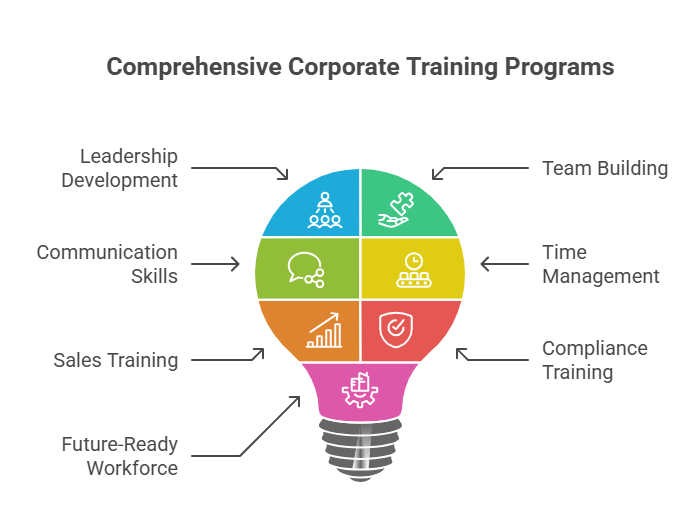
Key Takeaways
- Corporate training programs help develop employee skills, boost productivity, and strengthen workplace culture.
- Different program types, like leadership, team building, communication, and compliance training, target specific organisational goals and challenges.
- Choosing the right training requires aligning with strategic business objectives and addressing specific skill gaps.
- Common delivery methods include instructor-led training, eLearning, on-the-job training, blended learning, and simulations.
- Working with an experienced, customisable training provider ensures higher ROI and better employee engagement.
- Future-ready training programs focus on digital skills, innovation, and adaptability to prepare workforces for rapid change.
Introduction
Corporate training is a critical driver of both business efficiency and workplace attractiveness. It’s indispensable for companies seeking long-term success.
Beyond equipping employees with new competencies, well-designed training programs foster adaptability to industry changes. This not only boosts productivity but also stimulates innovation and a culture of continuous improvement.
In fact, entities that maintain corporate training programs are more likely to attract and retain top talent. However, to maximise corporate training impact, businesses should focus on aligning training initiatives with their strategic goals. This ensures that their workforce remains competitive, engaged, and prepared for future challenges.
In this guide, we will examine different corporate training programs and discuss the strategic value of corporate training. We shall also offer advice on how HRs can pick the best programs for their enterprises.
What is a corporate training program?
A corporate training program is a structured series of educational activities curated to upskill staff members, fill skill shortages, and foster their professional development. Principally, these activities aim to improve workers’ competencies and knowledge so they can contribute to the company’s success.
In practice, corporate training programs must align with an organisation’s goals so that the workforce is prepared to handle present and future business demands. These programs can take many disparate forms. For example, workshops, online courses, seminars, on-the-job training, and mentorship.
Read: What is Corporate Training and Why is it Important for Business Success?
Corporate training program examples for your organisation
Corporate training programs are mission-critical to developing a staff that’s knowledgeable, flexible, and driven. Various training programs focus on certain organisational requirements and skill sets, fostering professional development and business success.

Here are some notable instances of successful corporate training initiatives that can support the success of your company.
1. Corporate leadership development program
This program focuses on cultivating leadership skills mission-critical to guiding teams and driving strategic initiatives. In practice, it prepares current and future leaders to inspire teams in dynamic business environments whilst aligning with business goals.
Key Components:
- Strategic decision-making
- Effective communication
- Emotional intelligence
- Mentoring and coaching
When to Use:
- Developing high-potential employees for leadership roles
- Managing organisational change
- Enhancing leadership capabilities across teams
Best For:
- Mid- to senior-level managers
- Emerging leaders
- Department heads and project managers
2. Team building training
Team building training seeks to improve collaboration, trust, and communication among employees. Thereby, fostering a more cohesive and productive work environment.
Beyond addressing interpersonal challenges that affect productivity, it helps teams work cohesively toward common objectives. It’s especially useful when integrating new teams.
Key Components:
- Team roles and dynamics
- Communication and active listening
- Conflict resolution
- Collaborative problem-solving exercises
When to Use:
- Integrating new teams or departments
- Improving team morale and engagement
- Resolving conflicts and enhancing cooperation
Best For:
- Cross-functional teams
- Project teams
- Managers and supervisors
3. Communication skills training
Effective communication is the lifeblood of internal collaboration and excellent customer interactions. This unique training augments skills like active listening, assertiveness, negotiation, presentation, and business writing.
Consequently, it helps reduce misunderstandings and builds stronger relationships across all levels of the organisation.
Key Components:
- Active listening
- Assertiveness and negotiation
- Presentation skills
- Business writing
When to Use:
- Enhancing internal collaboration
- Improving customer service interactions
- Supporting leadership and sales teams
Best For:
- All employees
- Customer-facing roles
- Team leaders and managers
4. Time management training
Time management programs teach staff members how to prioritise tasks, create attainable goals, and control distractions. Employees with trouble managing their workload or being ready for periods of high demand would benefit from this training.
Key Components:
- Task prioritisation and goal setting
- Scheduling and planning
- Managing distractions
- Work-life balance strategies
When to Use:
- Addressing productivity challenges
- Preparing employees for high-demand periods
- Supporting new hires and managers
Best For:
- Employees at all levels
- Managers handling multiple projects
5. Sales training program
Sales training programs build the abilities needed to create leads, close sales, and preserve enduring connections with customers. All these elements contribute to increased revenue.
Generally, this program is mission-critical to entities seeking to extend overall sales effectiveness and onboard new sales employees.
Key Components:
- Lead generation techniques
- Closing strategies
- Product and market knowledge
- Customer relationship management (CRM)
When to Use:
- Onboarding new sales staff
- Launching new products or services
- Boosting sales team performance
Best For:
- Sales teams
- Account managers
- Business development professionals
6. Compliance training programs
Compliance training guarantees that employees comprehend and follow the laws and principles that are pertinent to their positions and sector. Frequent compliance training promotes a respectful, safe workplace and helps reduce hazards.
Key Components:
- Industry regulations and standards
- Workplace safety
- Data privacy and cybersecurity
- Anti-harassment and diversity policies
When to Use:
- Onboarding new employees
- Regulatory updates and audits
- Annual refresher training
Best For:
- All employees
- HR and compliance officers
- Managers in regulated industries
7. Future-ready workforce programs
These programs foster flexibility, digital literacy, and creative thinking to prepare workers for the evolving workplace. They are indispensable to help organisations stay competitive amid rapid change.
Key Components:
- Adaptability and resilience
- Technology and digital skills
- Innovation and creative problem-solving
- Sustainability and change management
When to Use:
- Supporting digital transformation initiatives
- Upskilling for emerging technologies
- Fostering a culture of continuous innovation
Best For:
- All employees
- Young professionals and new hires
- Teams undergoing change or growth
Here is an illustrative table summarising each of the above corporate training program types and their key components:
| Program | Key Components | When to Use | Best For |
|---|---|---|---|
| Leadership Development | Strategy, communication, and emotional intelligence | Leadership transitions, change | Managers, emerging leaders |
| Team Building | Team roles, communication, and conflict resolution | Team integration, morale boosting | Teams, supervisors |
| Communication Skills | Listening, negotiation, presentation, writing | Collaboration, customer service | All employees, leaders |
| Time Management | Prioritisation, planning, and distractions management | Productivity, onboarding | All employees, managers |
| Sales Training | Lead generation, closing, and product knowledge | New hires, product launches | Sales teams, account managers |
| Compliance Training | Regulations, safety, data privacy, ethics | Onboarding, audits, refresher | All employees, compliance roles |
| Future-Ready Workforce | Adaptability, tech skills, innovation | Digital transformation, upskilling | All employees, young talent |
Common corporate training methods
The most common corporate training methods can be categorised as:
- Instructor-Led Training (ILT): These are traditional classroom or virtual sessions led by an experienced trainer with immediate feedback.
- On-the-Job Training (OJT): This revolves around hands-on learning where employees acquire skills while performing actual job tasks.
- Blended Learning: This is a mix of instructor-led sessions and digital modules for flexibility and engagement.
- eLearning: This learning approach focuses on self-paced, scalable digital courses or modules accessible anytime.
Simulation and Role-Playing: This learning involves realistic scenarios or role-plays to practice skills and enhance problem-solving in a risk-free environment.
How to find the best corporate training programs that suit your business needs?
A corporate training program is a strategic decision that may significantly impact your entity’s growth trajectory, performance, and competitiveness.
To choose a program that truly fits your business, here are key considerations to guide your selection process:
- Commence by conducting a comprehensive needs assessment to identify skill gaps and knowledge deficiencies. This ensures the training program is relevant and aligned with your strategic priorities.
- Set SMART (Specific, Measurable, Achievable, Relevant, Timely) goals for what the training should accomplish. This helps with tailoring the program content and measuring its success effectively (ROI).
- Consider the learning formats and work arrangements of your employees that maximise engagement and fit your team’s schedules and preferences.
- Seek out training providers with proven expertise, relevant industry experience, and the ability to customise content to your disparate needs.
How to choose a corporate training provider?
To ensure your company gets the most out of its training investment, choosing a top corporate training provider is essential. Beyond providing high-quality content, the ideal supplier will also fit your company’s objectives, learning style, and culture.
Here are some important factors to consider when weighing pros and cons of training types:
- Ensure the prospective provider is a recognised and registered training entity. In fact, it should hold relevant industry certifications to guarantee compliance with quality standards.
- Seek out providers with experience in your specific industry and comprehension of your company’s culture and challenges. Such providers can customise content to be more relevant and practical for your employees.
- Evaluate training methodologies, curriculums and delivery formats as different training types have distinct advantages and limitations. For example, in-person training fosters direct interaction but might be less flexible. eLearning offers convenience but requires a lot of self-discipline.
- The competence and quality of trainers directly impact learning outcomes. So, verify trainers’ credentials, industry experience, and capacity to engage participants.
- Premier corporate training providers tailor their programs to an organisation’s goals. They incorporate relevant case studies, interactive role-plays, and practical exercises.
- Look for providers who provide tools to measure training effectiveness and demonstrate ROI. For instance, pre- and post-training assessments or performance metrics.
For trusted, customisable corporate training solutions, consider Thriving Talents, one of the top corporate training providers in Malaysia, known for aligning training with business needs.
Conclusion: Final thoughts
In summary, the different types of corporate training programs are intended to meet particular organisational requirements and staff development objectives.
For instance, leadership development aims to improve managerial and strategic capabilities; compliance training guarantees adherence to legal and regulatory standards; and skills-based training concentrates on job-specific technical abilities. To mention but a few.
Selecting the right cocktail of these training programs can significantly boost employee performance, engagement, and overall business efficiency.
For Malaysian entities seeking tailored corporate training solutions, reach out to Thriving Talents. We align training with your unique needs, provide expert guidance, and create the most effective training strategy for your diverse workforce.


